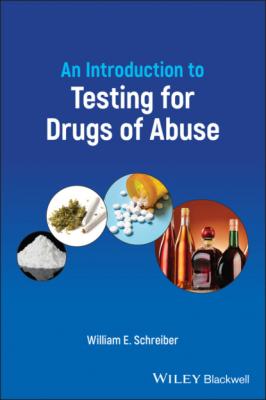An Introduction to Testing for Drugs of Abuse. William E. Schreiber
Читать онлайн.| Название | An Introduction to Testing for Drugs of Abuse |
|---|---|
| Автор произведения | William E. Schreiber |
| Жанр | Химия |
| Серия | |
| Издательство | Химия |
| Год выпуска | 0 |
| isbn | 9781119794073 |
169 172
170 173
171 174
172 175
173 176
174 177
175 179
176 180
177 181
178 182
179 183
180 184
181 185
182 186
183 187
184 188
185 189
186 190
187 191
188 192
189 193
190 194
191 195
An Introduction to Testing for Drugs of Abuse
William E. Schreiber
Clinical Director of Chemistry, LifeLabs
Professor, Department of Pathology and Laboratory Medicine
The University of British Columbia
Vancouver, Canada
This edition first published 2022 © 2022 John Wiley & Sons Ltd
All rights reserved. No part of this publication may be reproduced, stored in a retrieval system, or transmitted, in any form or by any means, electronic, mechanical, photocopying, recording or otherwise, except as permitted by law. Advice on how to obtain permission to reuse material from this title is available at http://www.wiley.com/go/permissions.
The right of William E. Schreiber to be identified as the author of this work has been asserted in accordance with law.
Registered Offices John Wiley & Sons, Inc., 111 River Street, Hoboken, NJ 07030, USA John Wiley & Sons Ltd, The Atrium, Southern Gate, Chichester, West Sussex, PO19 8SQ, UK
Editorial Office 9600 Garsington Road, Oxford, OX4 2DQ, UK
For details of our global editorial offices, customer services, and more information about Wiley products visit us at www.wiley.com.
Wiley also publishes its books in a variety of electronic formats and by print‐on‐demand. Some content that appears in standard print versions of this book may not be available in other formats.
Limit of Liability/Disclaimer of Warranty The contents of this work are intended to further general scientific research, understanding, and discussion only and are not intended and should not be relied upon as recommending or promoting scientific method, diagnosis, or treatment by physicians for any particular patient. In view of ongoing research, equipment modifications, changes in governmental regulations, and the constant flow of information relating to the use of medicines, equipment, and devices, the reader is urged to review and evaluate the information provided in the package insert or instructions for each medicine, equipment, or device for, among other things, any changes in the instructions or indication of usage and for added warnings and precautions. While the publisher and authors have used their best efforts in preparing this work, they make no representations or warranties with respect to the accuracy or completeness of the contents of this work and specifically disclaim all warranties, including without limitation any implied warranties of merchantability or fitness for a particular purpose. No warranty may be created or extended by sales representatives, written sales materials or promotional statements for this work. The fact that an organization, website, or product is referred to in this work as a citation and/or potential source of further information does not mean that the publisher and authors endorse the information or services the organization, website, or product may provide or recommendations it may make. This work is sold with the understanding that the publisher is not engaged in rendering professional services. The advice and strategies contained herein may not be suitable for your situation. You should consult with a specialist where appropriate. Further, readers should be aware that websites listed in this work may have changed or disappeared between when this work was written and when it is read. Neither the publisher nor authors shall be liable for any loss of profit or any other commercial damages, including but not limited to special, incidental, consequential, or other damages.
Library of Congress Cataloging‐in‐Publication Data
Names: Schreiber, William Edward, 1954– author.
Title: An introduction to testing for drugs of abuse / William Edward Schreiber, University of British Columbia, Vancouver, Canada.
Description: Hoboken, NJ : Wiley, 2022. | Includes bibliographical references and index.
Identifiers: LCCN 2021058984 (print) | LCCN 2021058985 (ebook) | ISBN 9781119794059 (paperback) | ISBN 9781119794066 (adobe pdf) | ISBN 9781119794073 (epub)
Subjects: LCSH: Drug testing.
Classification: LCC HV5823 .S45 2022 (print) | LCC HV5823 (ebook) | DDC 615.7/040724–dc23/eng/20220107
LC record available at https://lccn.loc.gov/2021058984
LC ebook record available at https://lccn.loc.gov/2021058985
Cover Design: Wiley
Cover Image: © luchschenF/Adobe, Kondor83/Shutterstock, Stephen Orsillo/ Shutterstock, monticello/Shutterstock
Preface
Toxicology is one of the most complex fields in laboratory medicine, and it is a frequent source of consultations. Doctors, nurses, patients, and other clients ask me a lot of questions about drug testing and what the results mean. Here are some examples.
Can passive exposure to marijuana smoke cause a positive test for cannabis?
Which drugs are detected by your amphetamine assay?
If my patient is taking oxycodone, why was the screening test for opiates negative?
How long can heroin be detected in a urine sample?
Could this level of cocaine in blood be fatal?
It has taken years to learn the answers and, perhaps more importantly, to locate the resources where those answers can be found. There is a huge literature on drugs of abuse and their measurement. However, it is hard to find a publication that summarizes both the testing process and the interpretation of test results. That is what laboratory and clinical practitioners need, and that is the subject of this book.
My goal is to provide a readable account of the most common drugs of abuse – what they are, how they work, therapeutic uses, potential for abuse, and how laboratories test for them. Enough practical information is included so that readers can understand and interpret the results of drug tests. The book is an introduction, not a compendium – more detailed information is available in textbooks, journal articles, and websites, some of which are listed at the end of each chapter.
Case
